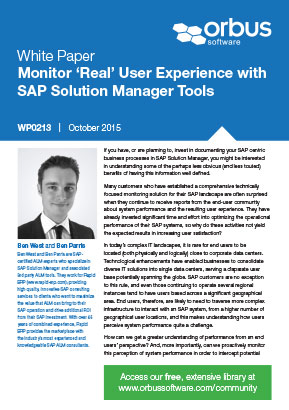As technology has enabled businesses to operate in more locations, in a global setting, this has naturally led to a more distant, diverse and remote IT operating user base. The complexity of IT infrastructure that end users must traverse in order to execute core business functions in a SAP centric IT landscape has increased, and ensuring the user base receives good quality, well performing IT services is no longer simply measurable by assessing core system performance within the data centre. This white paper discusses a solution to this problem, available free of charge from SAP themselves via your Solution Manager system: End User Experience Monitoring (EEM).
If you have, or are planning to, invest in documenting your SAP centric business processes in SAP Solution Manager, you might be interested in understanding some of the perhaps less obvious (and less touted) benefits of having this information well defined.
Many customers who have established a comprehensive technically focused monitoring solution for their SAP landscape are often surprised when they continue to receive reports from the end-user community about system performance and the resulting user experience. They have already invested significant time and effort into optimizing the operational performance of their SAP systems, so why do these activities not yield the expected results in increasing user satisfaction?
In today’s complex IT landscapes, it is rare for end users to be located (both physically and logically) close to corporate data centers. Technological enhancements have enabled businesses to consolidate diverse IT solutions into single data centers, serving a disparate user base potentially spanning the globe. SAP customers are no exception to this rule, and even those continuing to operate several regional instances tend to have users based across a significant geographical area. End users, therefore, are likely to need to traverse more complex infrastructure to interact with an SAP system, from a higher number of geographical user locations, and this makes understanding how users perceive system performance quite a challenge.
How can we get a greater understanding of performance from an end users’ perspective? And, more importantly, can we proactively monitor this perception of system performance in order to intercept potential issues and take corrective action before it has a negative business impact. There is a solution to this problem, and you might be surprised to hear that it is available free of charge from SAP themselves1 . It’s available via your Solution Manager system, and is called End User Experience Monitoring (EEM).
Login to continue reading.
